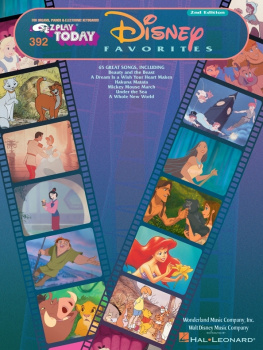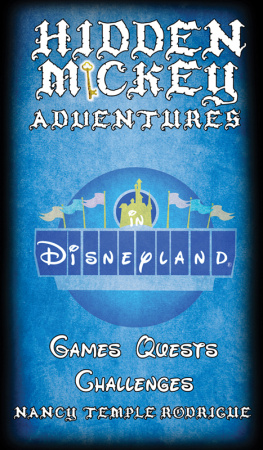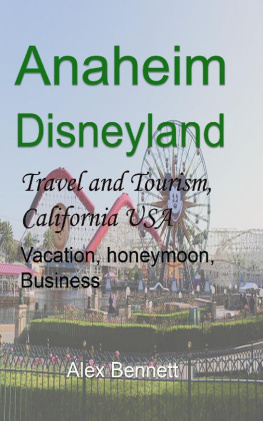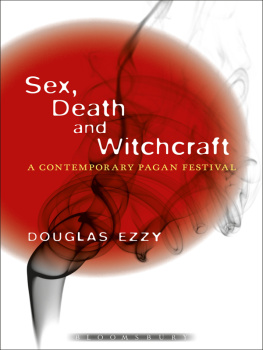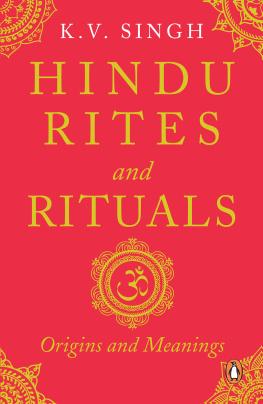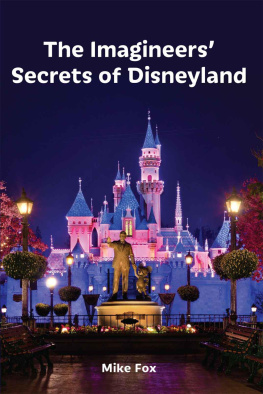Acknowledgements
Many people helped make this book possible. Id like to thank a few.
Thank you to my parents, David and Carolyn Santos for teaching me that our first and only duty to each other is to enact love.
Thank you to my best friend, fellow Din-no-phile, cheerleader-in-chief, and editor Britta K. Phillips for all the support, love, and vintage Disneyland goodies. Weve been at this party for 20 years and in no way is that depressing. I literally couldnt have written it without you.
Thank you to my friend and colleague Bonnie Willers for the support and discussion. I guess were done solving the worlds problems now, or at least Im taking a break. Its your turn, and I know itll be amazing.
Thank you to my Disney Studies colleagues Dr. Priscilla Hobbs and Dr. Amy M. Davis for your brilliance and for the sisterhood weve created. May all your Disney dreams come true.
Thank you to my publisher John Libbey for taking on a project from a fledgling author. Your patience with me through this process has been an unexpected blessing.
British Library Cataloguing in Publication Data
The Mouse and The Myth: Sacred Art and Secular Ritual at Disneyland
A catalogue entry for this book is available from the British Library
ISBN: 978-0-86196-727-8 (Paperback)
ISBN: 978-0-86196-932-6 (Electronic book)
Cover design: Pat McCallum.
Published by
John Libbey Publishing Ltd, 205 Crescent Road, East Barnet, Herts EN4 8SB, United Kingdom e-mail:
Distributed Worldwide by Indiana University Press, Herman B WellsLibrary350, 1320 E. 10th St., Bloomington, IN 47405, USA. www.iupress.indiana.edu
2017 Copyright John Libbey Publishing Ltd. All rights reserved.
Unauthorised duplication contravenes applicable laws.
Printed and bound in the United States of America..
Chapter 1
Tell Us a Myth, Wendy-Lady!
All Disneyland really is, you see, is a projection outward of the phenomenology of the imagination. And, if they cant go into their own imaginations, they might just as well go into Walt Disneys and hell help them. And thats what religions have done all the time. Joseph Campbell
The test of psychology is not, does it work? The test of psychology is: Is it fun? Does it amuse you? Does it delight you? Does it wake you up? Does it talk to your soul? Does it say anything to your soul that makes you see further or feel deeper or are inspired more or that the world around you is more animated or that you are more animated or that there is some beauty, or some love or some tragedy; some real things happening []. James Hillman
Introduction
I n the academic discourse between myth studies and archetypal theory, many are quick to accept a conventional attitude that contemporary popular culture is antithetical to the development of a psychologically fulfilling relationship with the imagination. These critics seem convinced that this is especially true of American popular culture. And frankly, theyre not entirely wrong. The frenetic pace of contemporary life can keep humanity disconnected from each other, a state that leads to both alienation from and negligence of the imagination. Lack of attention to the imagination is psychologically hazardous, because through it specifically through its relationship to ritual one cultivates an authentic connection with what Rudolf Otto refers to as the numinous: the awe-inspiring transcendence humanity has traditionally understood to be the touch of God(s). We yearn for what comparative mythologist Joseph Campbell insists is the most basic of existential needs: the experience of something real, a magical encounter between mundane events and the mysteries that exist beyond our empirical senses.
Whether we interpret these numinous moments to be the souls voice, the mind, or synapses in the brain, we cannot ignore humanitys yearning for them. This need is traditionally expressed, both individually and collectively, through the languages of mythology, theology, and psychology. Although at first glance these disciplines may seem unrelated, they address the same desire the development of a hermeneutic of the divine. They form a philosophical pyramid that develops and categorizes rituals steeped in thought, intuition, and action. Greek words Logos (word or the structures of reason), mythos (story, discourse, or plot), theos (numinosity or God), and psyche (breath or soul) essentially speak about the same things. These are languages we use to discuss big questions, such as: What does it mean to be human? How do we express our emotions? What do we do with our knowledge that some things are unexplainable? Is there truth in what seems to be miraculous? Does truth exist beyond empirical data? How do we relate to that truth?
Participation with myth and ritual is an outlet for this drive to make sense of our embodied condition. Participants of cherished mythic traditions do so by finding language to describe these transcendent moments. We tell stories to explain complicated emotions. We also engage in meaningful rituals, which then become hermeneutical metaphors. Mythology is essentially the souls metaphorical language processed through story. Likewise, ritual is the physical performance of the souls metaphors. Campbell writes:
The life of a mythology springs from and depends on the metaphoric vigor of its symbols. These deliver more than just an intellectual concept, for such is their inner character that they provide a sense of actual participation in a realization of transcendence. The symbol, energized by metaphor, conveys not just an idea of the infinite but some realization of the infinite.
He understands this relationship between symbol and transcendence to be the first, and perhaps the most vital, function of mythology. Following contemporaries C.G. Jung and Mircea Eliade, he proposes that symbols have the ability to bridge the gap between the numinous and the mundane. These symbols are the building blocks rituals use to shape culture. Despite any biases that argue against the imaginative efficacy of popular culture, the fact still remains that the Disneyland Resort offers such an experience to the devout patron, utilizing images, symbols, and the poetics of narrative to transcend the world outside the while continuing to shape and craft the mythology of the organization.
As I analyze Disneylands place in mythic ritual, I remain convinced that the excursion to Disneyland in Anaheim can, and does, function as psychologically transformative ritual, demonstrating that it becomes so through the way it crafts a unique interaction between traditional aspects of ritual: the souls journey to the imagination, the pilgrimage to a temple or shrine, an enchantment with image and spectacle, and an ever-evolving renewal practice. Furthermore, I see Southern California itself as iconic, and that Walt, his contemporaries, and subsequent artists utilize such factors as climate, movie magic, and Disneys own trusted brand as purveyor of myth to make the park such a place. Disneys kind of theme park could only have come about through the alchemical cauldron of Hollywoods mid-20th century film/fantasy industry.


